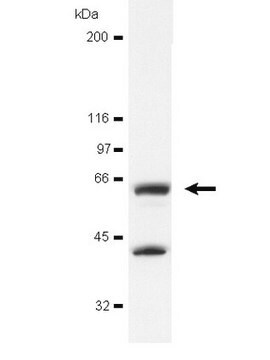05-184
Anti-Src Antibody, clone GD11
clone GD11, Upstate®, from mouse
Synonyme(s) :
Anti-ASV, Anti-SRC1, Anti-THC6, Anti-c-SRC, Anti-p60-Src
About This Item
Produits recommandés
Source biologique
mouse
Forme d'anticorps
purified immunoglobulin
Type de produit anticorps
primary antibodies
Clone
GD11, monoclonal
Espèces réactives
avian, mink, mouse, rat, human
Fabricant/nom de marque
Upstate®
Technique(s)
immunoprecipitation (IP): suitable
western blot: suitable
Isotype
IgG1
Numéro d'accès NCBI
Numéro d'accès UniProt
Conditions d'expédition
dry ice
Modification post-traductionnelle de la cible
unmodified
Informations sur le gène
human ... SRC(6714)
Description générale
Some tumor-inducing retroviruses (such as Rous sarcoma virus (RSV)), contain a gene called v-src (viral-sarcoma). It was found that the v-src gene in RSV is required for the formation of cancer.
Src tyrosine kinases transmit integrin-dependent signals central to cell movement and proliferation. Hallmarks of v-src induced transformation are rounding of the cell and the formation of actin rich podosomes on the basal surface of the cell. These structures are correlated with increased invasiveness, a process thought to be essential for metastasis.
v-src lacks the C-terminal inhibitory phosphorylation site, and is therefore constitutively active as opposed to normal src (c-src) which is only activated under certain circumstances where it is required (e.g. growth factor signaling). v-src is therefore an instructive example of an oncogene whereas c-src is a proto-oncogene.
Spécificité
Immunogène
Application
Signaling
Cytoskeletal Signaling
Qualité
Description de la cible
Forme physique
Stockage et stabilité
Remarque sur l'analyse
Positive Control Included: Non-Stim A431 Cell Lysate (12-301). Chicken Embryo Fibroblast (CEF) cells expressing Src protein and plated on fibronectin or Non-stimulated human A431 cell lysate
Informations légales
Clause de non-responsabilité
Not finding the right product?
Try our Outil de sélection de produits.
Code de la classe de stockage
10 - Combustible liquids
Classe de danger pour l'eau (WGK)
WGK 2
Certificats d'analyse (COA)
Recherchez un Certificats d'analyse (COA) en saisissant le numéro de lot du produit. Les numéros de lot figurent sur l'étiquette du produit après les mots "Lot" ou "Batch".
Déjà en possession de ce produit ?
Retrouvez la documentation relative aux produits que vous avez récemment achetés dans la Bibliothèque de documents.
Notre équipe de scientifiques dispose d'une expérience dans tous les secteurs de la recherche, notamment en sciences de la vie, science des matériaux, synthèse chimique, chromatographie, analyse et dans de nombreux autres domaines..
Contacter notre Service technique








